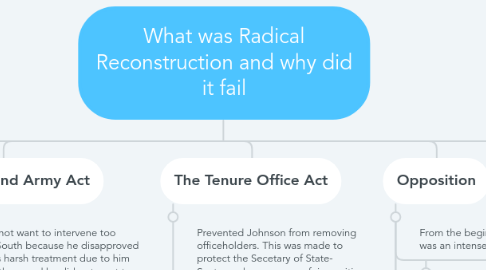
1. What was radical reconstruction?
1.1. It was the congressional plan for postwar recovery that imposed harsh standards on the Southern states and supported newly freed slaves ( now called freedmen) in their pursuit of political, economic, and social opportunities. During this era, Congress passed three constitutional amendments that protected the rights of freedmen.
2. Military Construction Bill
2.1. 1867
2.1.1. Forced military rule on the South. The ten states were grouped into five military districts- each was placed under a federal commander.
2.1.1.1. To be allowed entry into the Union, Southern states had to elect nation conventions that would accept black suffrage and accept the 14th amendment
3. The Command Army Act
3.1. Johnson did not want to intervene too much in the South because he disapproved of Congress's harsh treatment due to him being raised there and he did not want to lose the votes he had in the South
3.2. The act reduced Johnson's military powers
4. The Tenure Office Act
4.1. Prevented Johnson from removing officeholders. This was made to protect the Secetary of State- Santon- who was a very feirce critic of Johnson
5. Opposition
5.1. From the beginning of reconstruction there was an intense resistance in the South
5.1.1. The formation of the Ku Klux Klan as a result of this intense and violent opposition. The federal government passed three Enforcement Acts to strengthen the 14th and 15th amendments and try to limit discrimination
5.2. White Terror
5.2.1. The KKK were the most well-known group of racial extremists but there were many others. The White League in Louisiana, The Red Shirts in South Carolina and Mississippi
5.2.1.1. The men in these white supremacist groups were often ex-confederate soldiers.
5.2.1.1.1. The most common form of violent intimidation was lynching which involved eating and hanging victims by mob justice- there was no fair trail.
5.3. The Redeemers- these were people who fought for the redemption of the South. They represented conservative, pro-business southern Democrats
6. How effective was the opposition?
6.1. Due to the violence and intimidation the Republican vote from African- Americans were beginning to reduce
6.1.1. In Louisiana over 1000 people were killed in the 1868 elections- a large majority of them were freedmen.
7. The Failure
7.1. The Civil Rights Act of 1875 was the last major initiative of Radical Reconstruction
7.1.1. Congress were gaining less supporters and the amount of people sympathising with Southern opposition was rising.
7.2. Democratic control was restored in several Southern states.
7.2.1. The Amnesty Act of 1872- allowed large numbers of ex-Confederates to return to politics
